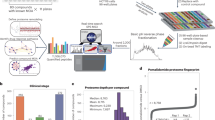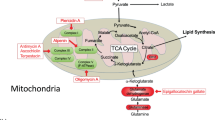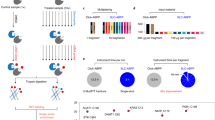Abstract
Chemical genomics aims to discover small molecules that affect biological processes through the perturbation of protein function1,2. However, determining the protein targets of bioactive compounds remains a formidable challenge3. We address this problem here through the creation of a natural product–inspired small-molecule library bearing protein-reactive elements. Cell-based screening identified a compound, MJE3, that inhibits breast cancer cell proliferation. In situ proteome reactivity profiling revealed that MJE3, but not other library members, covalently labeled the glycolytic enzyme phosphoglycerate mutase 1 (PGAM1), resulting in enzyme inhibition. Interestingly, MJE3 labeling and inhibition of PGAM1 were observed exclusively in intact cells. These results support the hypothesis that cancer cells depend on glycolysis for viability and promote PGAM1 as a potential therapeutic target. More generally, the incorporation of protein-reactive compounds into chemical genomics screens offers a means to discover targets of bioactive small molecules in living systems, thereby enabling downstream mechanistic investigations.
This is a preview of subscription content, access via your institution
Access options
Subscribe to this journal
Receive 12 print issues and online access
$209.00 per year
only $17.42 per issue
Buy this article
- Purchase on Springer Link
- Instant access to full article PDF
Prices may be subject to local taxes which are calculated during checkout




Similar content being viewed by others
References
Strausberg, R.L. & Schreiber, S.L. From knowing to controlling: a path from genomics to drugs using small molecule probes. Science 300, 294–295 (2003).
Stockwell, B.R. Exploring biology with small organic molecules. Nature 432, 846–854 (2004).
Burdine, L. & Kodadek, T. Target identification in chemical genetics: the (often) missing link. Chem. Biol. 11, 593–597 (2004).
Clemons, P.A. Complex phenotypic assays in high-throughput screening. Curr. Opin. Chem. Biol. 8, 334–338 (2004).
Schreiber, S.L. Target-oriented and diversity-oriented organic synthesis in drug discovery. Science 287, 1964–1969 (2000).
Dolma, S., Lessnick, S.L., Hahn, W.C. & Stockwell, B.R. Identification of genotype-selective antitumor agents using synthetic lethal chemical screening in engineered human tumor cells. Cancer Cell 3, 285–296 (2003).
Wu, X., Ding, S., Ding, Q., Gray, N.S. & Schultz, P.G. Small molecules that induce cardiomyogenesis in embryonic stem cells. J. Am. Chem. Soc. 126, 1590–1591 (2004).
Luesch, H. et al. A genome-wide overexpression screen in yeast for small-molecule target identification. Chem. Biol. 12, 55–63 (2005).
Robertson, J.G. Mechanistic basis of enzyme-targeted drugs. Biochemistry 44, 5561–5571 (2005).
Drahl, C., Cravatt, B.F. & Sorensen, E.J. Protein-reactive natural products. Angew. Chem. Int. Edn. Engl. 44, 5788–5809 (2005).
Liu, S., Widom, J., Kemp, C.W., Crews, C.M. & Clardy, J. Structure of human methionine aminopeptidase-2 complexed with fumagillin. Science 282, 1324–1327 (1998).
Wakabayashi, T., Kageyama-Kawase, R., Naruse, N., Funahashi, Y. & Yoshimatsu, K. Luminacins: a family of capillary tube formation inhibitors from Streptomyces sp. II. Biological activities. J. Antibiot. (Tokyo) 53, 591–596 (2000).
Nakajima, H. et al. New antitumor substances, FR901463, FR901464 and FR901465. II. Activities against experimental tumors in mice and mechanism of action. J. Antibiot. (Tokyo) 49, 1204–1211 (1996).
Speers, A.E., Adam, G.C. & Cravatt, B.F. Activity-based protein profiling in vivo using a copper(I)-catalyzed azide-alkyne [3 + 2] cycloaddition. J. Am. Chem. Soc. 125, 4686–4687 (2003).
Speers, A.E. & Cravatt, B.F. Profiling enzyme activities in vivo using click chemistry methods. Chem. Biol. 11, 535–546 (2004).
Taunton, J. How to starve a tumor. Chem. Biol. 4, 493–496 (1997).
Bogyo, M., Verhelst, S., Bellingard-Dubouchaud, V., Toba, S. & Greenbaum, D. Selective targeting of lysosomal cysteine proteases with radiolabeled electrophilic substrate analogs. Chem. Biol. 7, 27–38 (2000).
Herrchen, M. & Legler, G. Identification of an essential carboxylate group at the active site of lacZ beta-galactosidase from Escherichia coli. Eur. J. Biochem. 138, 527–531 (1984).
White, M.F. & Fothergill-Gilmore, L.A. Development of a mutagenesis, expression and purification system for yeast phosphoglycerate mutase. Investigation of the role of active-site His181. Eur. J. Biochem. 207, 709–714 (1992).
Speers, A.E. & Cravatt, B.F. A tandem orthogonal proteolysis strategy for high-content chemical proteomics. J. Am. Chem. Soc. 127, 10018–10019 (2005).
Wang, Y. et al. Crystal structure of human B-type phosphoglycerate mutase bound with citrate. Biochem. Biophys. Res. Commun. 331, 1207–1215 (2005).
Sirois, S., Hatzakis, G., Wei, D., Du, Q. & Chou, K.C. Assessment of chemical libraries for their druggability. Comput. Biol. Chem. 29, 55–67 (2005).
Gatenby, R.A. & Gillies, R.J. Why do cancers have high aerobic glycolysis? Nat. Rev. Cancer 4, 891–899 (2004).
Rigden, D.J., Walter, R.A., Phillips, S.E. & Fothergill-Gilmore, L.A. Polyanionic inhibitors of phosphoglycerate mutase: combined structural and biochemical analysis. J. Mol. Biol. 289, 691–699 (1999).
Engel, M., Mazurek, S., Eigenbrodt, E. & Welter, C. Phosphoglycerate mutase-derived polypeptide inhibits glycolytic flux and induces cell growth arrest in tumor cell lines. J. Biol. Chem. 279, 35803–35812 (2004).
Kondoh, H. et al. Glycolytic enzymes can modulate cellular life span. Cancer Res. 65, 177–185 (2005).
Kung, C. et al. Chemical genomic profiling to identify intracellular targets of a multiplex kinase inhibitor. Proc. Natl. Acad. Sci. USA 102, 3587–3592 (2005).
Wong, S. et al. Sole BCR-ABL inhibition is insufficient to eliminate all myeloproliferative disorder cell populations. Proc. Natl. Acad. Sci. USA 101, 17456–17461 (2004).
Mazurek, S., Zwerschke, W., Jansen-Durr, P. & Eigenbrodt, E. Effects of the human papilloma virus HPV-16 E7 oncoprotein on glycolysis and glutaminolysis: role of pyruvate kinase type M2 and the glycolytic-enzyme complex. Biochem. J. 356, 247–256 (2001).
Leung, D., Hardouin, C., Boger, D.L. & Cravatt, B.F. Discovering potent and selective reversible inhibitors of enzymes in complex proteomes. Nat. Biotechnol. 21, 687–691 (2003).
Acknowledgements
We thank J. Tamiya for valuable contributions to the initial design of the probe library and A. Speers for assistance with the identification of the probe labeling site on PGAM1. This work was supported by the National Institutes of Health grant CA087660 (to B.F.C.), the California Breast Cancer Research Foundation (B.F.C.), a Merck Fellowship of the Life Sciences Research Foundation (A.S.) and the Skaggs Institute for Chemical Biology.
Author information
Authors and Affiliations
Corresponding author
Ethics declarations
Competing interests
The authors declare no competing financial interests.
Supplementary information
Supplementary Fig. 1
Synthesis of a natural products-inspired spiroepoxide probe library. (PDF 168 kb)
Supplementary Fig. 2
Structures of the amine substituents of various MJE probes. (PDF 94 kb)
Supplementary Fig. 3
Evaluation of the anti-proliferation effects and in situ proteome reactivity profiles of spiroepoxide probes. (PDF 688 kb)
Supplementary Fig. 4
MJE3 inhibition of PGAM1 catalytic activity in living cells. (PDF 82 kb)
Supplementary Fig. 5
Characterization of the site of MJE3 labeling in PGAM1. (PDF 398 kb)
Supplementary Fig. 6
Structure-activity relationship of the anti-proliferative effects and PGAM1 labeling by MJE3. (PDF 195 kb)
Rights and permissions
About this article
Cite this article
Evans, M., Saghatelian, A., Sorensen, E. et al. Target discovery in small-molecule cell-based screens by in situ proteome reactivity profiling. Nat Biotechnol 23, 1303–1307 (2005). https://doi.org/10.1038/nbt1149
Received:
Accepted:
Published:
Issue Date:
DOI: https://doi.org/10.1038/nbt1149
This article is cited by
-
Transcriptional regulation and post-translational modifications in the glycolytic pathway for targeted cancer therapy
Acta Pharmacologica Sinica (2024)
-
The emerging role of mass spectrometry-based proteomics in drug discovery
Nature Reviews Drug Discovery (2022)
-
Phosphoglyceric acid mutase-1 contributes to oncogenic mTOR-mediated tumor growth and confers non-small cell lung cancer patients with poor prognosis
Cell Death & Differentiation (2018)
-
Conformation and dynamics of the C-terminal region in human phosphoglycerate mutase 1
Acta Pharmacologica Sinica (2017)
-
Global profiling of lysine reactivity and ligandability in the human proteome
Nature Chemistry (2017)



